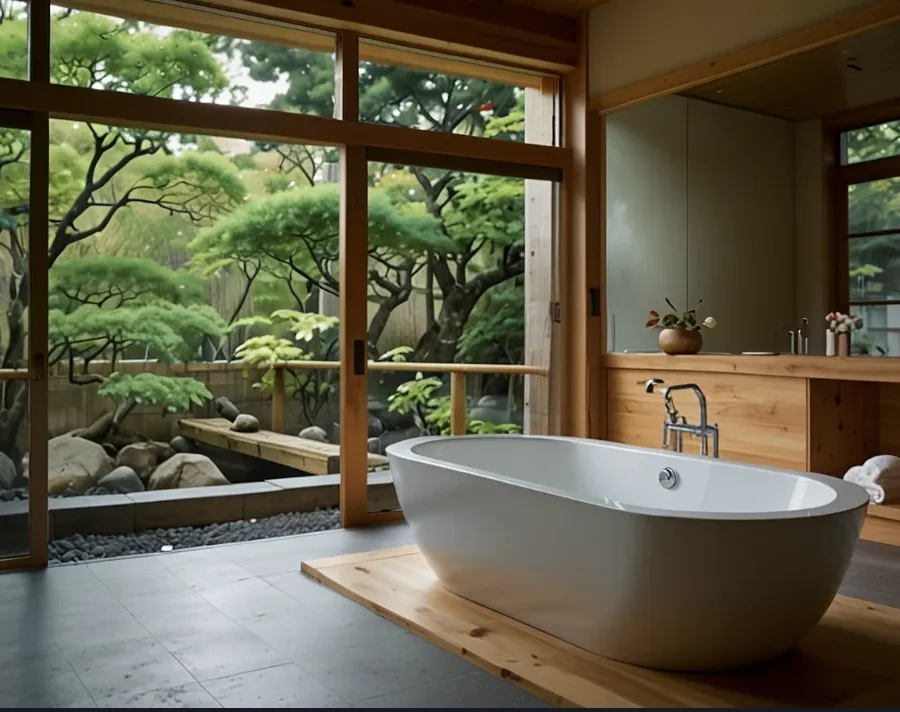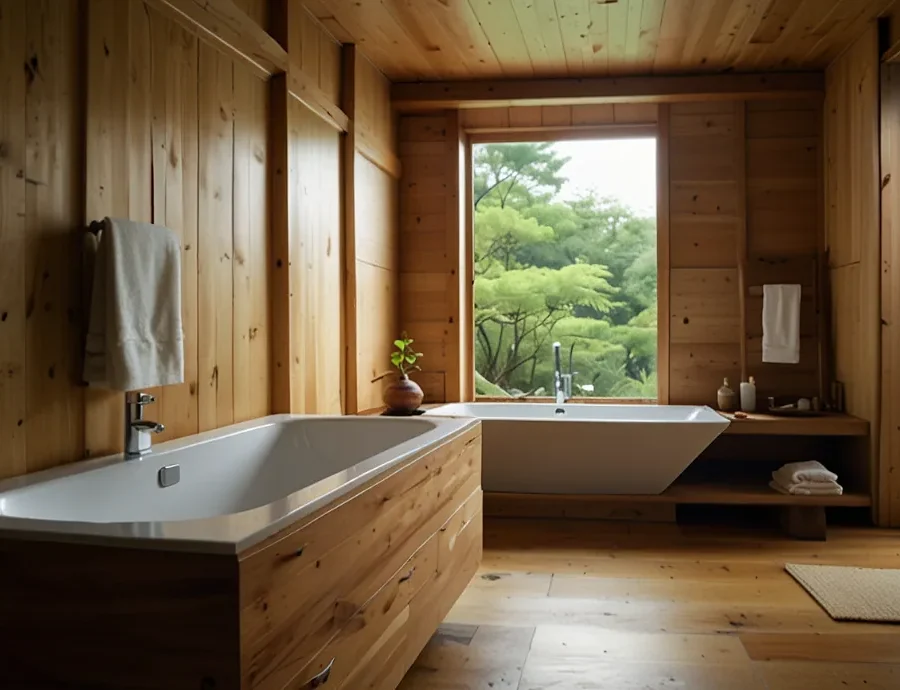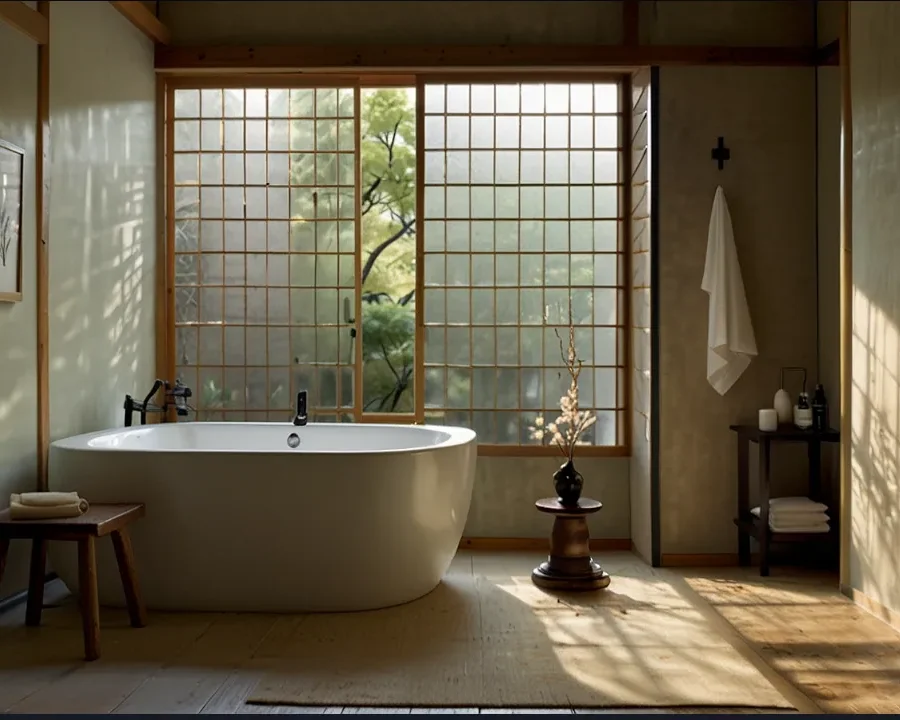13 Japanese style bathroom ideas perfect for a serene minimalist retreat
A Japanese-style bathroom is more than simply a place to get cleaned up — it’s a sanctuary for relaxation and a place that reflects simplicity, tranquility and a connection with nature. Influenced by Zen philosophy, the Japanese bathroom emphasizes natural materials, soft lighting, and a generally serene aesthetic. Whether you’re looking to create a spa-like retreat or prefer to work in subtle Japanese touches to your bathroom as it already is, here are 15 Japanese-style bathroom ideas to bring a sense of serenity into your space.
1.Ofuro — The soaking tub for complete relaxation

A traditional Japanese soaking tub, or ofuro, is meant for deep immersion and relaxation. These baths are deeper than Western bathtubs and often constructed of natural materials such as cedar, hinoki wood or stone. The goal? To make it a spa-like experience that relaxes the body and soul.
📌 Pro Tip: Make sure to get a proper wooden bath stool and a small basin for an authentic Japanese bathing setup with your ofuro.
2. Natural Wood Components for Heat and Feel

Natural wood (and sometimes other natural materials) are often used in Japanese bathrooms to bridge the gap between home and nature. Wooden elements, including teak, bamboo and hinoki wood, lend an organic touch to the space.
📌 Pro Tip: Incorporate natural materials into your design with wooden wall panels, a slatted ceiling, or a teak shower mat.
3. Stones and Pebbles for a Zen feel

Japanese aesthetics are mostly based around stone and pebbles, which make Japanese bathroom a nice grounding space. You can use pebbles in shower floors, sink, or as a decorative accent for an authentic onsen (hot spring) experience.
📌 Pro Tip: Use river stones to adorn the shower floor or put in a stone basin sink for that quintessential Zen feel.
4.Shoji Screens That Slide For Soft Privacy

Japanese bathrooms also frequently use shoji screens instead of doors — the sliding doors have wooden frames and translucent paper panels. The screens are designed to let in natural light while preserving privacy.
📌 Pro Tip: If sliding real shoji screens don’t make sense for your space, consider frosted glass partitions or bamboo blinds for a similar look.
5.The Minimalist Design Approach to Decluttering
“We reduce clutter: nothing is left there without a purpose, and no unnecessary stuff, Japan is minimalist by bathroom design.” Not-only the decor, clean lines, neutral colors, and secret storage solutions keep an open and tranquil space.
📌 Pro Tip: Floating vanities, recessed shelves and simple décor will keep the space feeling clutter-free and serene.
6.Wooden Platforms Open Showers
Parquet floors are more common in traditional Japanese bathrooms, where open-concept showers are equipped with a wooden platform that lets water drain through a space underneath. The setup is similar to a wet-and-dry room, in which the main bathing area is demarcated from the rest of the bathroom.
📌 Pro Tip: Use teak or hinoki wood for the shower platform to avoid mold and moisture damage.
7.Color Palette in Neutral and Earthy Tones
Soft, earthy colors such as beige, taupe, gray and muted greens represent the calming elements of the natural world, a guiding principle in Japanese design. They generate a calm and grounded space.
🏡 Pro Tip: The use of natural stone tiles, bamboo accents and soft lighting will help achieve the effect.
8.An Autumn of Indoor Plants and Fresh Air
One of the most important aspects of Japanese design is bringing the beauty of nature indoors.” You can add ferns, bamboo, or even bonsai plants to infuse freshness and support the Zen feel.
📌Pro Tip: To make your zen bath experience even more immersive, set a small potted plant around a tub or install a wall of living moss.
9.Soft and Ambient Lighting for Calming Atmosphere
Lighting: Japanese-style bathrooms use warm, diffused lighting instead of harsh lights. With this it creates a very calm and welcoming ambiance.
📌 Pro Tip: Soft illumination is essential; use paper lanterns, recessed LED lighting, or dimmable sconces.
10.Wooden stools and buckets used in the traditional way
In Japanese bathing culture, you wash before you soak. Wooden stools and buckets for rinsing off before entering the ofuro tub.
📌 Pro Tip: Get yourself a cedar (or hinoki) stool, a matching bucket and fill it with water for the real pre-bath experience.
11.Waterfall Faucets for an Effortless Flow
A waterfall-style faucet flows like nature, contributing to the serene feel of the bathroom.
📌 Pro Tip: For a modern, yet vintage appeal, place a wall-mounted waterfall faucet upon a stone sink or tub.
12.Onsen-Inspired Steam Showers
If you can’t go to a Japanese onsen, why not bring the experience home? A steam shower works a lot like the bath you could find in a hot spring, but with long-term therapeutic benefits.
📌 Pro Tip: Natural stone tiles and warm wood accents add to the feeling of a spa.
Japan is famed for its high-tech toilet technology, which includes features like heated seats, bidet features and self-cleaning technology. They not only bring comfort but also enhance hygiene and efficiency.
📌 Pro Tip: Consider a wall-mounted smart toilet with eco-friendly water-saving components.
13.A Touch of Bamboo for a Natural Look
Bamboo is a staple of Japanese interiors, and it pairs well with bathroom design. From bamboo flooring to towel racks to decorative panels, all the bamboo lends a light, airy and organic feel to the space.
The solution: bamboo blinds or a slatted bamboo partition will add privacy, but still retain a natural look. 【📌 Pro Tip】
The Japanese-style bathroom isn’t just a design choice— it allows for creating a calming retreat where relaxation and simplicity are at the forefront. From an ofuro soaking tub to natural stone touches to minimalist design, these ideas will inspire you to create a serene, spa-like bathroom sanctuary.
What is your favorite Japanese bath ideas from these? Let us know in the comments!







